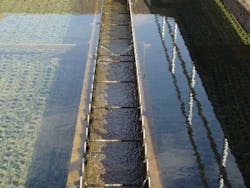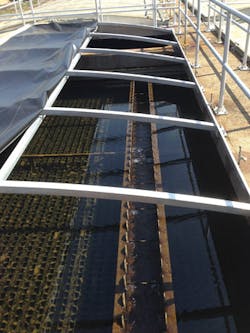Troublesome Algae Disappears from Clarksville Water Treatment Plant
By Phillip Whittinghill, Randall Gillum and Brent Howe
The Clarksville Water System is one of the largest in Tennessee, and serves approximately 160,000 people with 66,000 connections. The system consists of a water treatment plant and a distribution system, which is regulated by the Tennessee Department of Environment and Conservation’s (TDEC) Drinking Water Division and Environmental Protection Agency (EPA) regulations. Clarksville’s water treatment plant is situated on an 11 acre (4.5 hectare) site beside the Cumberland River, the city’s source of water. The plant was built in 1951 and has been regularly upgraded in response to the city’s growing industrial, commercial, and residential needs.
In 2008, a large industry came to the city and required that 4 MGD be added to the plant’s capacity. The Clarksville Gas and Water management team decided to upgrade the plant to better meet current and future regulations. As part of the upgrade, plant management decided to adopt membrane filtration and change coagulants.
The expansion increased the plant’s capacity to 28 MGD with peak rates of 32 MGD (85-92 GFD flux rating). Another decision was made to address issues related to severe algae growth in the plant’s six sedimentation basins. Through research and trials, including the addition of chemicals, ultrasonic technology, and physically covering areas of the basins, management determined the best long-term method of controlling the algae would be installing basin covers.
Prior to the addition of the basin covers, algae grew rampant on basin walls and floors, which caused taste and odor issues and elevated disinfectant byproduct production. Water plant maintenance personnel removed algae build-up, but algae accumulated so rapidly that maintenance on the basins was required four to six times per year. Servicing the basins meant wasting valuable resources, including water and manpower.
To combat the problem, plant management knew they needed to block sunlight. Operators had experimented with several options, including the addition of carbon to the water to partially block sunlight and limit algae growth. On their own initiative, the operators also tested a trial tarp-style cover on the tube settlers and saw positive indications of algae control. Still, a proper cover was required. Plant management retained an engineering consultant to investigate options for a permanent solution, including erecting a building over the tanks.
After evaluating basin cover alternatives, plant management ultimately chose retractable, structurally supported covers from Geomembrane Technologies Inc. (GTI). The GTI cover system consists of retractable vinyl coated fabric panels tensioned over supporting aluminum arches.The fabric covers are UV-protected, strong, and can be quickly disconnected and easily rolled open to provide access to tank internals. Custom weighted fabric hatches added to the covers allow easy access for sampling and inspection when necessary.
Six months after the installation was complete, plant operators rolled open the GTI covers and were surprised to find that the tank walls, including the tube settlers, were algae-free. “Investing in the GTI covers was one of the best things we ever did,” said Phillip Whittinghill, plant superintendent and senior manager at the Clarksville Water Treatment Plant. “They have resulted in unquestionable savings.”
The plant does not pre-chlorinate due to the formation of potential disinfection byproducts (DBPs). The structurally supported covers allow the plant to combat algae without the use of chemicals that promote the formation of DBPs. “We don’t need to feed pre-chlorine, which is huge because that helps our water quality - we avoid DBPs,” said Randall Gillum, assistant superintendent and manager at the Clarksville Water Treatment Plant.
Since the covers are custom-designed for local code loads, they hold up very well even in bad weather. The structural integrity of the covers was proven one winter when several 4-6 inch (10-15 cm) snowfalls accumulated on the covers.
In addition to controlling algae at the plant, the covers are stopping dirt and debris from entering the basins. The plant, which is surrounded by trees, previously struggled each autumn with leaves and branches falling into the basins and settling to the bottom. This is no longer an issue: dirt and debris that would have entered the basins is now caught on the covers to be washed off by plant personnel. “We haven’t had a minute’s worth of trouble with them,” said Whittinghill.
About the Authors: Phillip Whittinghill is the plant superintendent and senior manager at the Clarksville Water Treatment Plant. Randall Gillum is the assistant superintendent and manager at the Clarksville Water Treatment Plant. Brent Howe is the vice president of product management for structurally supported covers at Geomembrane Technologies Inc. (GTI). He can be reached via email at [email protected].
More WaterWorld Current Issue Articles
More WaterWorld Archives Issue Articles



